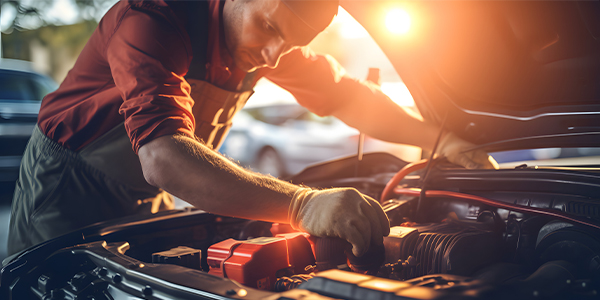There have been a lot of headlines lately about global warming, climate change, environmental concerns and high gasoline prices. These are huge, complex issues with no easy answers. The bottom line is the world has a lot of people driving a lot of cars, and they are burning up a lot of fuel.
There are now more cars than licensed drivers in the U.S. What’s more, according to the 2007-2008 World Motor Vehicle Market Report, published by the Overseas Automotive Council, the world vehicle population reached 789.8 million vehicles in 2005 — enough to circle the globe 120 times if you lined them all up end to end! The vehicle population is growing about 7% a year, so by the end of 2008 there will probably be more than 1 billion vehicles worldwide.
It’s unlikely the world’s known petroleum reserves can sustain this kind of growth indefinitely, or that the atmosphere can continue to absorb the carbon dioxide emissions from such a growing human and vehicle population without suffering additional climate change.
That brings us to the concept of driving green. Driving green means driving in a more environmentally friendly manner. To many people, that means getting rid of their full-size SUV or truck and getting a smaller, more fuel-efficient vehicle or a hybrid that gets better fuel economy and produces less CO2. To others, it means driving a flex-fuel vehicle that can be driven on E85 ethanol made from corn, or a diesel-powered vehicle that can burn biodiesel made from soybeans or used cooking grease. Driving green also means driving less or not at all (consolidating shopping trips, shopping online, car pooling, moving back into the city or relocating closer to work, riding a bike, walking, etc.).
You don’t necessarily have to own a Toyota Prius to drive green, or get a minicar like a Honda Fit, Nissan Yarus or MINI Cooper to reduce your carbon impact on the environment. All you have to do is drive smarter, drive smaller and drive less.
I’ve been driving green for a long time because I work at home and don’t commute into the office. When I bought a used minivan six years ago, I found a used Low Emission Vehicle (LEV) Ford Windstar from California. Though very clean emissions-wise, the van never got very good fuel economy (20 to 21 mpg at best with a tailwind). So when the transmission failed at 85,000 miles (typical of Ford AX4S transmissions), I replaced the Windstar with a much more fuel-efficient Mazda MPV (26 to 28 mpg highway). If we didn’t need the utility of a van (I can’t give up the ability to haul 4×8 sheets of plywood just yet), I probably would have bought a hybrid.
Where I live has also enabled me to minimize the miles I have to drive. Our house is just one block away from our grocery store, three blocks from our church, and less than a mile from our local schools, post office and library. Walking is good exercise and it doesn’t add any carbon to the atmosphere other than the CO2 I exhale.
Don’t misunderstand. I’m a car guy, always have been and always will be. I like to drive — just not in rush hour bumper-to-bumper traffic. My entire career has revolved around automotive service and repair. So the more cars there are on the road and the more miles they are driven, the better it is for me, my publisher, our advertisers and our readers.
But I also recognize the fact that cars are having an enormous impact on the quality of life in most urban areas. Urban gridlock and suburban sprawl is out of control. People are moving further and further from where they work to find affordable housing. So cities continue to spread, commutes get longer, traffic gets more congested, and we pump more and more CO2 into the atmosphere.
An important point the media often fails to mention is that cars are not the only contributors to global warming and climate change. Deforestation in Third World countries and coal burning in China, India, Russia and elsewhere are having as much if not more of an impact on the balance of atmospheric carbon. According to a United Nations report on data collected in 2003, the United States produced 21.2% of the world’s total carbon dioxide (5.8 thousand metric tons). That sounds like a lot, and it is. But it also means almost 80% of carbon dioxide is coming from sources beyond our borders and beyond our control. China is a close second with 15.2% of the world’s total CO2 emissions, and their carbon emissions are growing by leaps and bounds along with their economy. Russia is another big polluter. One city in Russia alone produces more pollution than the entire United Kingdom (Norilsk, Siberia, home of Russia’s nickel smelting industry). Think they give a shitusky about the environment?
We can’t fix the rest of the world. But neither can we ignore the fact that CO2 contributes to global warming and that CO2 is having an effect on the climate. If you don’t believe it, rent Al Gore’s documentary An Inconvenient Truth.
Whether you agree with Al Gore or not, there are plenty of things we can do to minimize carbon emissions. We can maintain our vehicles so they get the best possible fuel economy. We can drive smarter to reduce the total number of miles driven. We can downsize to smaller, more fuel-efficient vehicles or buy hybrids. We can increase our use renewable fuels such as E85 and biodiesel from domestic sources. And we can all hope for the day when plug-in hybrids that run mostly on electricity, or fuel-cell-powered electric vehicles that produce no CO2 at all will be available. Until then, I’m doing what I can to drive green.








